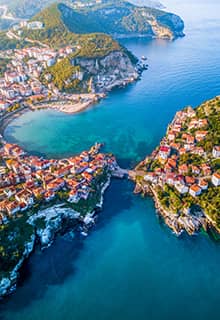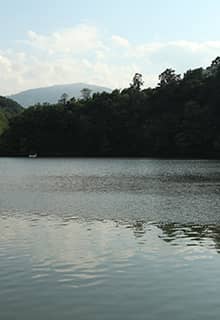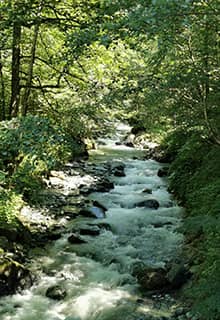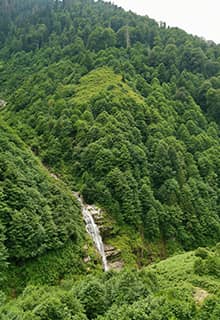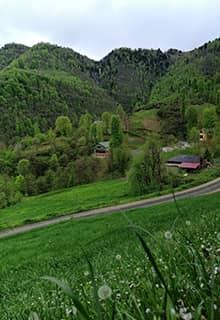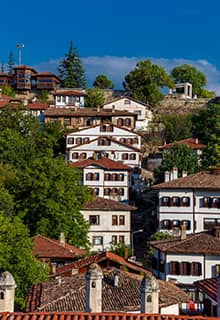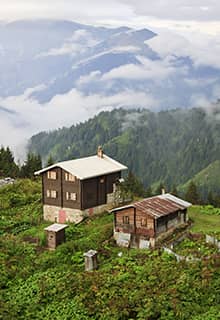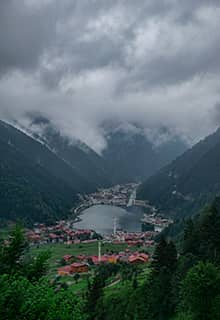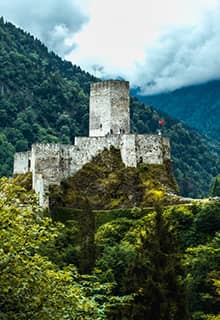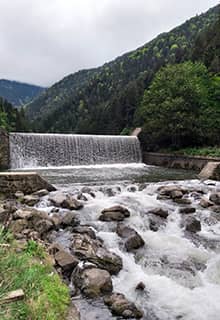

see
Black Sea Türkiye
Sümela Monastery in Trabzon
The 1000 years old Monastery of the Virgin Mary or Sümela Monastery is among the most impressive sights of Türkiye’s Black Sea coast. Its name came from its location where was previously known as Mela Mountain.
Sümela Monastery is an Orthodox monastery dedicated to the Virgin Mary. Known as the Monastery of Virgin Mary by the local people, it was founded in the 4th century CE as the dream of two monks named Barnabas and Sophronios, who built a small church here. Sümela was expanded into a monastery during the Byzantine Empire period and has become a science and culture centre with its rich library.
Throughout the centuries, the Sümela Monastery has been influenced by many different civilisations. During the time of the Eastern Roman Emperor, it was used as a place for education and coronation ceremonies. During the date of the Ottoman Empire, the monastery also played a significant role. To show respect to the Monastery, the Ottoman sultans bestowed a variety of gifts on the monastery over many years.
Located in the Maçka district, the monastery is a site of historical and cultural significance. It was included in UNESCO's temporary list of World Heritage sites in 2000.
Due to risk of rocks falling over, Sümela Monastery was closed to visits in September 2015. After four years of restoration, it was reopened for visits in July 2020. Restoration works at the majestic monastery have been completed after landscaping, investigation, and strengthening of the geological and geotechnical maintenance of rocks were carried out at the monastic complex.
Zil Castle in Rize
Zil Castle is one of the most distinctive monuments of Rize. 15 kilometers south of the district centre, it is established on the western slopes of Fırtına Stream. The rock mass on which the castle was built is 750 meters above sea level and 100 meters above the stream bed. The castle comprises of outer walls, middle walls, and the inner citadel. A pathway from the northwest leads to the door of the outer walls. There are three important buildings within the middle walls: the guard house, the chapel, and the main tower. The beam traces and holes on the wall shows that the tower used to have four floors.
Historic Prison in Sinop
Sinop Historic Prison has been the subject of movies, songs, and poems. Its history dating back thousands of years, and it has a special geographical location.
After Sinop was conquered by the Anatolian Seljuks in 1214, an inner castle was built by the order of Sultan İzzeddin Keykavus. There are 11 bastions in the inner castle. The inner castle has also been used as a shipyard since its construction. The bastions of the inner castle, which have been used as a shipyard for a long time since the Seljuk Period, have been used as dungeons since 1560. The Historical Sinop Prison, which was once defined as the Alkatraz of Anatolia was closed in 1999 and converted into a museum.
Historical Cittaslow’s in Bolu
Located between two biggest cities of Türkiye, İstanbul and Ankara, Bolu has two historical towns called Göynük and Mudurnu. Both towns are the members of “Cittaslow Movement”.
Göynük is an old Ottoman town with exceptionally well-preserved architecture. The district's historical traditions and culture, the local attire, folklore, and cuisine are still alive today. The entire residential area of Göynük is protected. The nearby Lakes Sünnet and Çubuk have not been developed and offer an escape into pristine nature.
Mudurnu is famous for the more than 180 historical buildings and old houses. This historical town is located 17 km southwest of Lake Abant. The lake’s scenery is fascinating, and its woodlands include scots pines, European black pines, beeches, oaks, poplars, ashes, hornbeams, willows, junipers, hazels, and common medlars.
The Safranbolu Houses in Karabük
Located eight km north of Karabük city center, Safranbolu is under conservation since 1975, and entered the UNESCO World Heritage List in 1994.
Safranbolu enjoyed a great architectural development during the 17th and 18th century. Encircling Safranbolu's historic buildings, the Safranbolu houses in the centre of the district consist of about 2,000 traditional Turkish houses. About 800 of these houses are under legal preservation.
In addition to houses, the castle, the hamams, the bazaars, inns, mosques, the old government house, and its unique and civil architectural buildings are the major places of interest in Safranbolu.
Hattusa in Çorum
Hattusa was the capital of the Hittite Empire in the late Bronze Age.
Hattusa, which has been on the UNESCO World Cultural Heritage List since 1986, is located within Çorum city.
Hattusa became the capital of the Hittites in the 17th century BCE. Most of the ruins of the city which survive until today, are from the 13th century BCE. In Büyükkale, where royal buildings were located, the remains of a large palace have been unearthed, including the courtyards surrounded by pole galleries, residences, storage buildings and a large reception hall.
With the collapse of the Hittite Empire just after 1200 BCE, the Anatolian Bronze Ages had also ended. However, the land where the city of Hattusa is located continued to be a settlement.
The settlement in Hattusa continues in the Persian period as well. It also carries the traces of Hellenistic, Galatian, Roman and Byzantine settlements and fortifications.
Bandırma Ferry in Samsun
Bandırma Ferry was an Ottoman mixed-freight ship. It became famous for its historical role in taking Atatürk, the founding father of the Republic of Türkiye, from İstanbul to Samsun in May 1919 that marked the establishment of the Turkish national movement.
The project initiated by the Governorship of Samsun in 1999 for the construction of a replica of the Bandırma ferry that carried Mustafa Kemal Atatürk to Samsun with his comrades in arms from İstanbul was completed in 2001 and officially opened in 2003. As a result of the landscaping studies and additions made by Samsun Metropolitan Municipality in the following years, Bandırma Ferry and National Struggle Park have been turned into an Open-Air Museum.
Yason Burnu Peninsula and Yason Church in Ordu
Yason Burnu, which is one of the places worth seeing with its natural beauty, is located on the Samsun-Ordu highway in Perşembe district. The church, built in 1869, became one of the most important attraction centers of Ordu with its location by the sea after it was restored and landscaped according to its original form and opened to visitors. This is the only peninsula with a church along the Black Sea coast. It is where the Argonaut Legend took place.
The Historical Mansions in Kastamonu
The historical Kastamonu Mansions were built at the end of the 19th century and in the first half of the 20th century. They are important examples of civil architecture that reflects Turkish society life to this day. The mansions can be visited through the narrow streets and sometimes by stairs due to the uneven structure of the city. Because of safety reasons and the geographical structure of the city, the mansions were built close to each other.
The most important feature of the mansions, especially those situated in the city centre where the front facade of each building has its own architectural design and aesthetics. The basic idea in civil architecture is to prevent a blockage from the neighbour's sun, shadow, or view, as well as to make the most of the area.
You can visit the restored mansions, stay overnight in one of the mansions serving as a hotel, and enjoy the local Kastamonu delicacies in the warm atmosphere of the mansions.
Mine Museum in Zonguldak
The mine in Zonguldak was first opened in the 1880s. This area is used as an education center today. The pit has an underground opening of about one km and all mining units are available except he underground well. In this area, which is very close to the city center, today there is a Mine Museum, an exhibition hall and a cafeteria.

